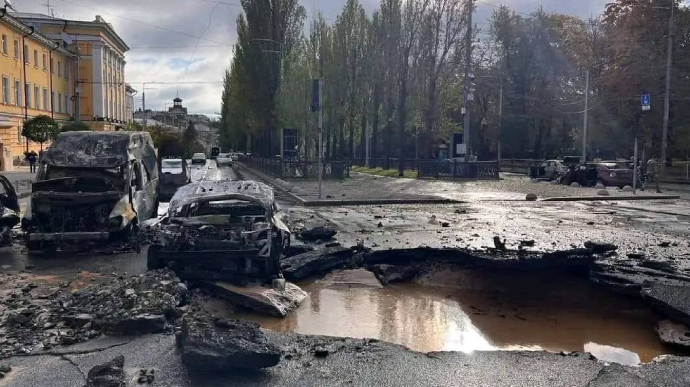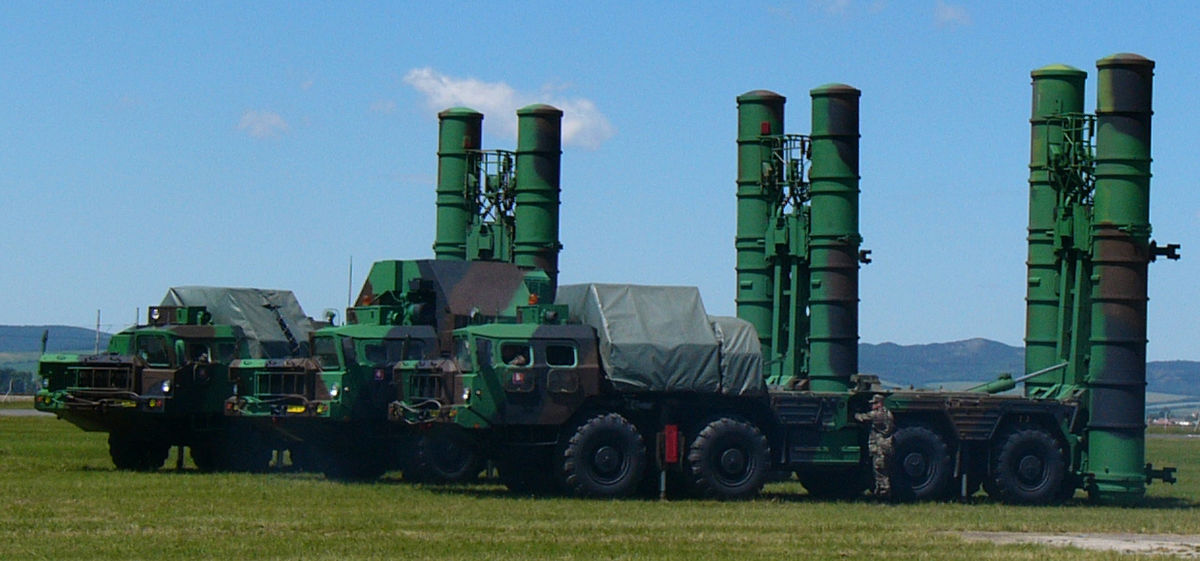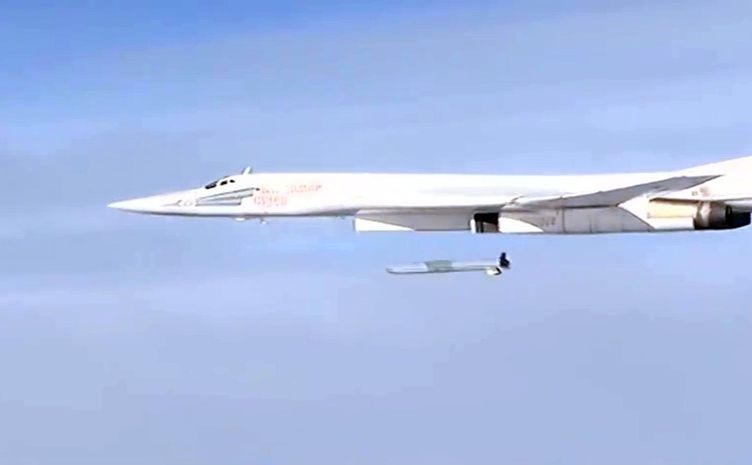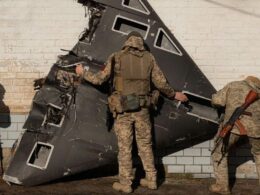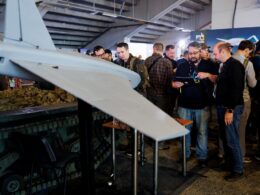On 10 October, Ukraine saw unprecedented Russian missile strikes. 84 missiles were launched throughout the country; they killed at least 19 civilians and were reported to hit civilian targets. Particularly, they left a crater where a playground had once stood near Ukraine’s top university in Kyiv and killed civilians commuting to work at a busy intersection. More strikes followed the next day.
These attacks hit roughly 30% of Ukraine’s energy infrastructure. As a result, Ukrainian cities and regions are suffering from rolling blackouts and Ukraine has suspended its electricity exports to the EU.
These attacks were estimated to cost Russia $400-700 mn and have, admittedly, caused inconveniences for Ukraine. However, from the military viewpoint, they were useless: they will not help Russia achieve an advantage on the battlefield. Here is why.
Russian missile strike was prepared long before Crimea bridge explosion
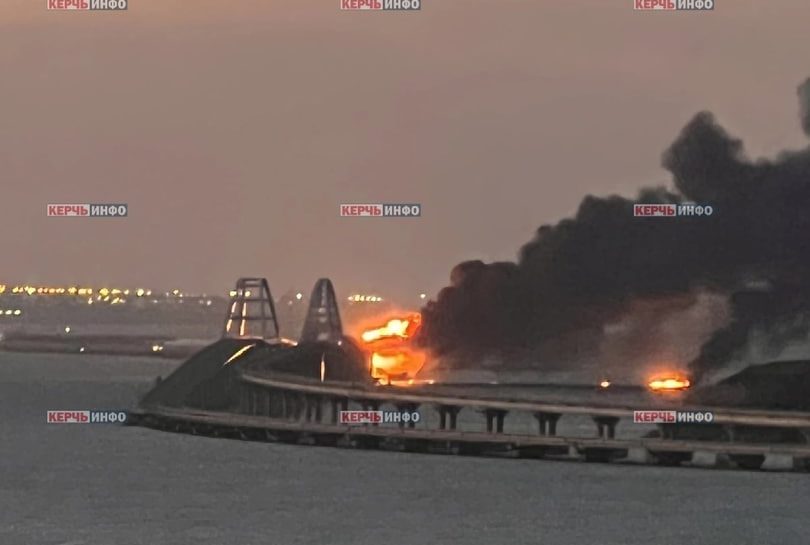
According to Ukraine’s Main Intelligence Directorate, Russia planned the strikes since early October, long before an explosion partially destroyed the Kerch bridge linking Russia to the occupied peninsula of Crimea on 8 October.
Ukraine’s Intelligence wrote in a release that Russian occupying forces were instructed to prepare massive strikes targeting critical civil infrastructure and central areas of Ukrainian cities on 2-3 October. The final decision was made on 9 October and was connected to the appointment of General Surovikin, the new commander of Russia’s occupation troops in Ukraine, according to Ukrainian Intelligence spokesman Andriy Yusov.
“They needed to quickly demonstrate some ostensibly real results and conduct this political-psychological operation,” the intelligence officer explained.
Main purpose of missile strike: to give Russians back home "something to celebrate"

Mykola Bielieskov, a Research Fellow at the National Institute for Strategic Studies under the President of Ukraine, agrees with this assessment. The main purpose of the strikes is to give Russians back home "something to celebrate" and to divert attention from their failures on the battleground, and the Crimean bridge served only as an “excuse,” he told Euromaidan Press.
“For such an intensive strike, two days is vastly insufficient. Transporting the missiles, loading the ships, planning who gets what target -- this is not a task for two days. Yes, Putin tried to accuse Ukraine and say that the bridge is a civilian object, but I don't think anybody believed him, as the whole world understands that its primary purpose is a military one.
In reality, Putin needed to let the steam out. We can say that the main driver of Russia’s mass missile strikes is the losing streak of the Russian Army in Ukraine and the criticism and internal instability that Putin faced because of this. Something needed to be done to distract Russians from the fact that the Russian front in Ukraine is barely holding up,” Bielieskov said.
Similarly, the Institute for Study of War believes that the goal of the strikes is to rehabilitate the public image of the Russian Ministry of Defense and coincided with information operations to rehabilitate the public image of General Aleksandr Lapin following Russian failures around Lyman. The appointment of Surovikin, “a hero in the extremist nationalist Russian information space,” is intended to cater to radical Russian nationalist warmongers, who were frustrated with Russian setbacks in Donbas, the Institute wrote.
It noted that Russian military bloggers, who express the positions of the warmongers, lauded both the massive strikes on October 10 and Surovikin’s appointment, correlating the two as positive developments for Russian operations in Ukraine.
“The Russian army has faced a month of defeats, the Russian media landscape was boiling with criticism, countering which was impossible. The military leadership changed constantly and attempts to find scapegoats among the military were made, but it all didn't work, and they needed to create a show for the internal audience,” Mykola Bielieskov sums up.
A missile show with no military goal
Did the strike have a military goal? Not according to Ukraine’s intelligence, whose spokesman Andriy Yusov called the strike “one of the most senseless terrorist actions in the history of the Putin regime”:
“The whole world saw that the strikes are primarily aimed at civilian objects, civilians, energy infrastructure, which ensures the vital activity of civilian objects,” Yusov said, stressing that Ukraine's military infrastructure and defense capabilities were almost not damaged as a result of these strikes.
This contrasts with a statement of Russia’s Ministry of Defense claiming, without evidence, that it struck Ukrainian army fuel and ammunition depots.
Mykola Bielieskov sees no military goal in the strikes, either.
“If we are talking about blows to power facilities, it's to make life difficult before the winter. But if we're talking about purely military goals, it was a no-starter from the get-go. Russians can't change the fact that they don't have enough cruise missiles, and fairly inaccurate ones at that, to change the course of war in a country as large as Ukraine.”
The inaccuracy of Russian missiles is on display of a video when a missile narrowly missed a glass pedestrian bridge in Kyiv:
Russians tried to destroy a popular pedestrian bridge in central Kyiv https://t.co/GQmsFCMLQR
— Euromaidan Press (@EuromaidanPress) October 10, 2022
What can we expect from the appointment of General Surovikin?
Not only Russian commentators connected the missile attack with the ascension of General Sergei Surovikin, who on 8 October was appointed to lead Russia’s invasion forces in Ukraine. His background of heading the Russian Aerospace Forces and leading Russian troops in Syria, as well as the moniker used by Kremlin-affiliated media, “General Armageddon,” led many to think that pummeling civilian facilities will now be the new style of Russian invasion forces and Syria-like atrocities will follow.
Russia appoints first public commander of Ukraine invasion forces
Not so, writes the Institute for Study of War, reminding that brutalizing civilian populations was Russia’s modus operandi in Syria whether Surovikin was in command or not. As well, the Institute notes, Syrianizing the war in Ukraine is impossible: Russia faces a whole different set of challenges.
And, most importantly, it did not achieve air superiority in Ukraine.
“Let’s look at his time in Syria. The Russians used a total of 300 cruise missiles in Syria [compared to over 3,500 in Ukraine as of September], but the main blows were delivered by piloted aviation which carpet-bombed the cities. If they don't have air superiority, they can send a hundred, three hundred missiles; it won't secure their victory,” Mykola Bielieskov told.
What can Surovikin’s appointment change? According to Bielieskov, nothing: the structural problems in the Russian army, which include insufficient forces to hold a long frontline, low morale, and lacking equipment and training, all of which were exposed during Russia’s recent snap mobilization announcement, are too great. One person cannot change them all.
“I think he will repeat the fate of previous commanders like Dvorkin and others. Soon he will become the object of sharp criticism and the main scapegoat,” Bielieskov said.
Russia’s snap mobilization unlikely to have impact on course of war – ISW
All Ukraine needs is for its partners to continue supplying with the air defenses needed to prevent Russia from establishing air superiority, the ISW stresses. Otherwise, we should not expect any changes in the Russo-Ukrainian war.
Russia is losing on the battlefield
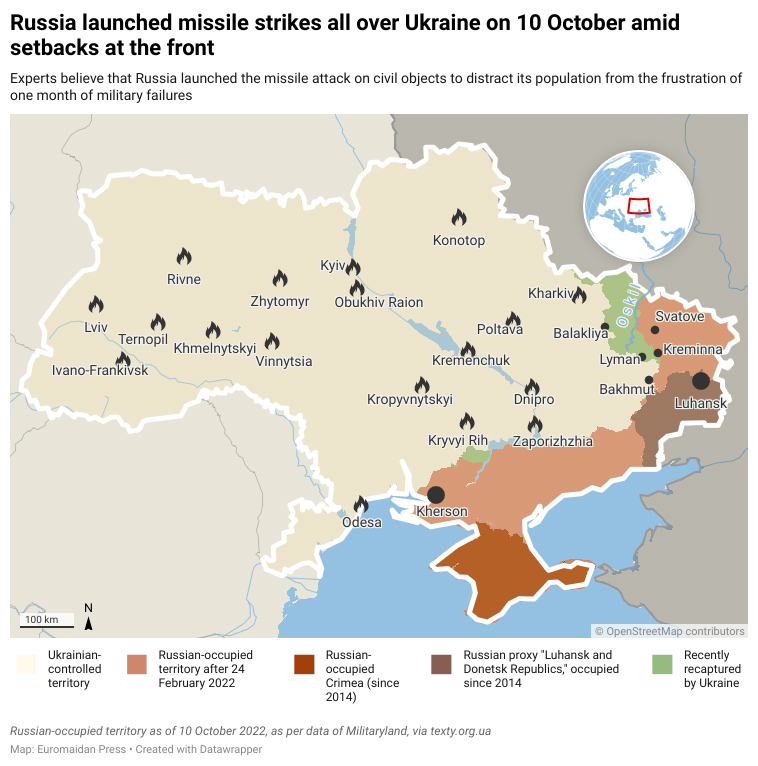
To put this missile attack into context, we must recall the unprecedented Ukrainian offensive dubbed the “Balakliia blitzkrieg,” which started in early September and is still ongoing. After rapidly liberating from Russian occupation broad stretches of land to the east of Balakliia, Ukrainian forces succeeded in crossing the critical Oskil river and are now advancing towards Luhansk Oblast.
“We’re still pushing them along the front, but not with the power as we had with Balakliia-Kupiansk and Lyman. Both the Russian and Ukrainian armies are exhausted, and the tempo of advance is not as fast as it was. But in any case, Ukraine tries try to push out the Russians, to dig in and create a line of defense, not allowing them to rest, with the goal of reaching Svatove and Kreminna,” Bielieskov told.
The advance is also taking place in northern Kherson Oblast, where Ukraine is reaping the results of its numerous strikes on Dnipro river crossings that cut off a grouping of the invaders in the north amid a month of positional battles. It is the exhaustion of enemy and destroyed logistical routes that allowed the Ukrainian army to advance rapidly in the north, where the concentration of Russians is smaller.
However, Russia is making incremental progress at Bakhmut and Marinka – something that Bielieskov calls “strategic nonsense” for “purely political motives,” as it happens while Russians get pummeled and retreat in two other directions.
“And maybe personal motives of Evgeny Prigozhin and his Wagner group, so they would be able to say ‘Mom, look’ when they try to advance at least somehow near Bakhmut, even though they are trying to do this for three months and Bakhmut is still Ukrainian (and is extremely likely to stay so). So, their situation is quite difficult and the missile strikes serve as a way to distract all the media, including the international media, from this fact,” he adds.
Could Ukraine expect such attacks to happen more often with Ukrainian successes at the front?
“This is strange logic; it would mean that we shouldn't fight at all because it could provoke Putin. And I doubt that Russia could hold up this intensity of strikes for long; it's very likely that these missiles were taken from their ‘safety stock.’ Their production capacities are not as they used to be; and if everything was alright with their missiles, they would keep using them and would not buy Shahed-106 drones in such quantities,” Mykola Bielieskov stresses.
If such strikes happen again, they will be singular events when Putin, again, will need to “let steam out” and present at least some semblance of success.
“Because they don't know how to fight on the front, they fight with the civilian population. But it was this way from the very start,” Bielieskov sums up.
What missiles were used and can Iranian Shahed-106 drones replace them?
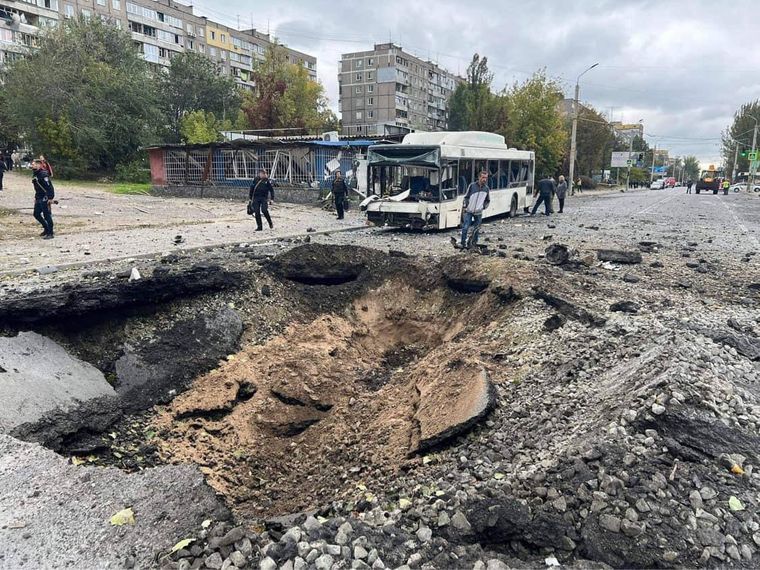
A total of 83 missiles were launched, most of them airborne Kh-101 and Kh-555 missiles launched from eight Tu-95 and three Tu-160 bombers above the Caspian Sea. As well, seaborne Kalibr missiles were launched from the Black Sea, land-borne Iskander missiles launched from various directions, missiles of the anti-aircraft systems S-300 and "Tornado-S."
Ukraine’s air defense shot down 45 -- more than half, a rate that Ukrainian military officials say is excellent.
Russia is running out of these high-precision missiles, according to various estimates. Particularly, experts note that the fact that Russia uses anti-ship and modified anti-aircraft missiles to strike land targets means it is exhausting its stocks of the precise variety. And the production of new precise missiles, which require electronics, is greatly limited by western sanctions against Russia.
“They used their ‘safety stock’ stashed in case of a war with NATO,” Bielieskov says, stressing that the missile strike on 10 October is an extraordinary event.
As well, Ukraine shot down nine of 12 Iranian Shahed-106 kamikaze drones. Ukraine’s Air Force reported
recently that Russia is using the drones instead of the precision missiles it is running out of.
This is why missiles from storage were used for the attack, not drones, stresses Bielieskov.
In any case, a war cannot be won with missiles alone.
“Missiles were used by the Americans, for instance, as part of operations to establish air superiority. After this was reached, piloted aviation was used, not expensive missiles. So even the Americans didn't allow themselves to just work with missiles without any military targets. So, this episode of playing with missiles won't change anything on the stage of theater of combat operations,” he adds.
Can Ukraine repel Russian missile attacks?
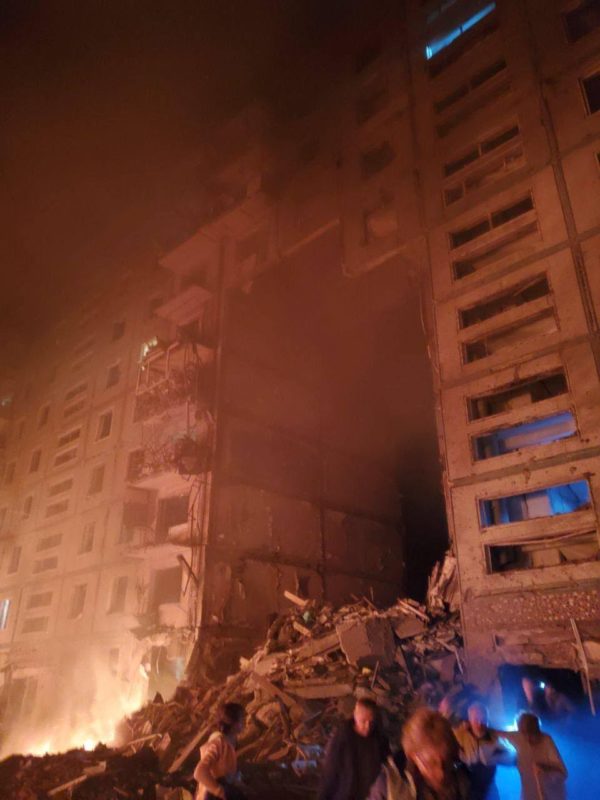
Recently, two of Ukraine’s top generals penned an article stating that Ukraine will really win the war against Russia only if its capacity to strike objects at a distance is evened out, as now Russia can strike Ukraine from over 1,000 km away with impunity.
However, the chances of this happening are small, Bielieskov tells. The existing missile technology control regime allows transferring only missiles with ranges under 300 km and warheads under 500 kg can be transferred.
“Air defense and ATACMS are the ceiling of our ambitions. We won't be able to reach the base of Russia's strategic aviation in the city of Engels,” he says.
The USA and UK have transferred HIMARS and M-270 MLRS to Ukraine, however equipping them with GMLRS missiles with a range of up to 70 km. The ATACMS missile will allow Ukraine to shoot up to 300 km. Delivering ATACMS to Ukraine is one of the objectives of Ukraine’s leadership, yet the administration of Joe Biden is reluctant to deliver them due to fears of provoking Russia.
This is why Ukraine needs to create a system of passive defense, aka bomb shelters, like Israel had before a system of tiered air defense was developed following strikes in 1991.
“Ukraine is too large for us to be able to fully cover it with air defense. However, more importantly, we must be able to fight the land groups of enemy forces. Missiles are bad, but not worse than piloted aviation or classical artillery,” Bielieskov states.
Indeed, Russia wreaks the greatest devastation to Ukrainian cities happens 70-80 kilometers from the front, within the reach of Russian Grads and S-300 systems. The cities of Zaporizhzhia and Mykolaiv, as well as frontline towns in eastern Ukraine, get pummeled daily, with civilians being killed on a similar scale as from the missile strikes on 10 October.
“If we have ATACMS, we will be able to strike the groupings that present the greatest danger there. The air defense systems promised by Germany and the US will cover half of Ukraine’s needs at most. So, we need to prepare for this threat persisting. But our main goal is to fight the Russian ground forces. If we are able to do that, well, the missile terror is something we will have to live with, but by itself it does not allow to impose Russia's political will,” Bielieskov sums up.
Related:
- The air defense Ukraine needs to stop Russia's missile terror
- Russia appoints first public commander of Ukraine invasion forces
- Ukraine’s counteroffensive near Kharkiv: what enabled the Balakliia blitzkrieg
- What will partial mobilization in Russia change?
- What Ukraine really needs to launch a counteroffensive against Russia
- Javelins are good, but it is artillery strikes that coined Ukraine’s military success
- Ukraine needs long-range missiles to really win the war, country’s top generals say
- Ukraine repairs roads smashed by Russian missiles in Kyiv, Dnipro overnight – PHOTOS

